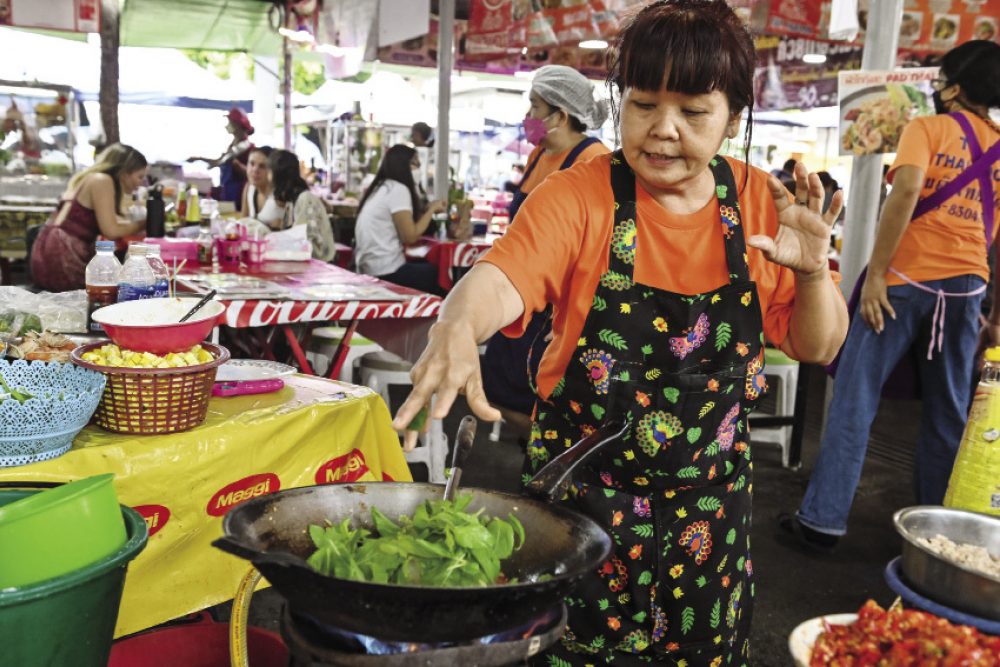Where the tracks end and the market begins is a line blurred by more than a century of delicious commerce. The Mae Klong Railway Market, a sprawling affair of seafood and produce tucked up to the Gulf of Thailand. Heaps of garlic and tiny silver fish, red chilies and prawns, syrupy mangos. All flow freely from vendors’ trays and tables onto the tracks.
Opened in 1905, the market’s mission was to ease the transport of seafood to Bangkok some 90 kilometers away. Today, awnings green, yellow and blue stretch directly over the tracks that bisect the market. Boxes of fruit, fish and vegetables balance on the trestles as shoppers meander down the tracks, purchasing from either side.
Several times a day, trains still trundle through, triggering an unhurried dance in which vendors pull their wares inward—some have mounted their tables on wheels for ease—just as the engine arrives, then immediately push back onto the tracks once the last car passes. An amazing, seemingly impossible choreography.
Such are the markets of Thailand. Each more surprising than the next. Some are chaotic, spilling coconuts and seafood onto city streets buzzing with tuk-tuks. Others are clusters of canoe-like boats, overflowing with fruit and the makings of pad Thai while gliding serenely down blue-green canals, money and food moving hand to hand, back and forth, ship to shore.
But for me, the most delicious market experience happened to be the most conventional.
The Chatuchak Weekend Market in central Bangkok. It begins as an outer ring of vendors—hundreds clustered tight in a wide loop—offering mostly housewares and clothing, random knickknacks and souvenirs. Little to excite the wandering eater. Until you push inward through the throngs of shoppers. That’s when you find yourself at the heart of the market.
A central tent shading yet another ring, this time nothing but food vendors, their woks filling the air with smoke and sizzling oil, whiffs of chili, lime and fish sauce. They encircle a sprawl of folding chairs and tables, workers racing to deliver oversized bottles of beer, plates of pad Thai and innumerable other stir-fries to clusters of diners.

Noi Chamoi Tachantont uses basil by the fistful.
The options overwhelm. Luckily, that’s when I meet Noi Chamoi Tachantont, longtime cook at a stand named Tak Thai Food. She offers me Thailand’s equivalent of comfort food—pad kraprao, one of a family of dishes sometimes called drunken noodles or drunken rice (depending on your starch of choice).
“If you don’t know what to eat, you eat this!” she says. “We eat this every day. It wakes you up!”
I soon learn why. Tachantont’s wok is perched precariously on thin legs, her ingredients arranged on tables all around her. With a flick of flame, she starts. First oil, which immediately sends smoke billowing. Then crushed fresh chilies, which fill the air with intensity. Ground pork, garlic and various sauces sweet and savory are next, creating a swirl of richness around us.
It’s the final step that surprises me. Fresh holy basil—the local peppery, minty variety—added not meagerly, as we so often do with herbs, but wantonly and gloriously by the fistful, so much that the basil briefly obscures the meat. That is, until it wilts into the stir-fry to become a delicious bright green tangle woven through the dish.
The dish is done in minutes, quickly heaped onto a plate with rice. The taste is ... outrageous. Rich with peppery basil, big pops of chili heat (which did, indeed, wake me up). The pork is tender and deeply savory, but also lightly sweet. The basil balances it all with tons of fresh, herbal notes. It’s so good, I order a second plate.
As for that reference to inebriation? Theories vary, though most popular is that it’s the food you eat after a long night of drinking. Others say the name honors the dish’s potent flavors, said to cut through even a drunken palate. Either way, I certainly felt woken up. And definitely appreciated one of those tall beers alongside.







